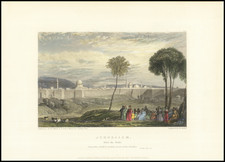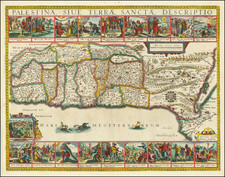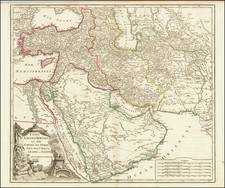Brandis' map of the Holy Land is generally regarded as the first modern map ever printed.
This 1475 map of the Holy Land is regarded as the first modern printed map because it is not derived from a classical source (Ptolemy), nor is it in the circular schematic format characteristic of medieval maps. However, it retains two attributes of earlier maps: it is "oriented" with east at the top, and Jerusalem is at the center. The geographic information is taken from a lost 13th Century manuscript map by a Dominican pilgrim, Burchard of Mt. Sion. The map appeared in Rudimentum Novitiorum and was printed on two wood blocks.
In this bird's-eye view, topographic features are portrayed with reasonable accuracy, and cities and regions are depicted as stylized hills. Jerusalem is dominant, represented as a circular walled city overlooked by the Mount of Olives, with Bethlehem nearby on the right. Egypt and Gaza are in the lower right corner; the port of Jaffa is at the bottom center; the walled city of Acre ("Accon") is to the left of Jerusalem; and Damascus is at the upper left border. Crudely illustrated Biblical scenes include Egyptians drowning in the Red Sea (lower right), Moses receiving the Tablets of the Law on Mount Sinai (upper right corner), spires of the submerged cities of Sodom and Gomorrah protruding from the Dead Sea (upper right), the Baptism of Jesus (upper center), and the Crucifixion (below Jerusalem). Compass directions are indicated by eight "wind-blowers" at the edges of the map.











![[Cyprus, Holy Land, Syria & Middle East] Tabula Asiae IIII](https://storage.googleapis.com/raremaps/img/small/82782.jpg)
![[ Palestine ] Beschreibung des Heiligen Landes](https://storage.googleapis.com/raremaps/img/small/96981.jpg)
![[ Tribes of Zabulun Issachar, Manasseh ] Tribus Zabulon, Isachar, et, Dimidia Manasse altera, hoc est illae Terrae Sanctae regiones . . .](https://storage.googleapis.com/raremaps/img/small/95602.jpg)
